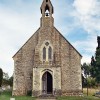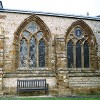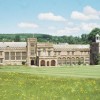Thomas Sydenham was one of the three foremost Dorset men of medicine (the others were Francis Glisson and Frederick Treves,) but of the 17th century, when scientific and medical knowledge was in its infancy and riddled with superstition. Of his earliest years next to nothing is known, other than that he was born at Wynford Eagle in 1624, the eighth in a family of ten children.
While still in his teens he entered Magdalen Hall in Oxford where at 18 he matriculated as a Fellow Commoner. When Magdalen later merged with Hertford College, Sydenham underwent another two years of uninterrupted studies. But the Principal was a leader of the Puritan Party at Oxford and through his indoctrination Thomas joined the movement.
As the Sydenhams were a military family, Thomas left Oxford in 1642 to fight on the Parliamentary side in the Civil War, in the ranks of which two of his brothers also served, but who were killed in action. Thomas himself was once wounded, while on another occasion he was falsely given up for dead.
He was able to return to Oxford in 1647, where he had the good fortune of an introduction to Dr Thomas Coxe, then treating his brother, and it was as a consequence of this chance meeting that Sydenham was persuaded to take up medicine. He became a Fellow Commoner at Wadham College and in 1648 was created Bachelor of Medicine. However, this BM was granted by the then Chancellor, the Earl of Pembroke, without a degree in the arts first having been taken. Sydenham then later took his MA, but when hostilities broke out again in 1648 he returned to army service for a time as a Captain.
Home again after the war, Thomas married Mary Gee at Wynford Eagle and following his resignation from an All Souls Fellowship, was free to pursue a double career in medicine and politics. After an unsuccessful attempt to enter Richard Cromwell’s Parliament as MP for Weymouth he made his home and set up his practice at Westminster. Sydenham attended lectures at Montpelier, the chief seat of Hippocratism and there learnt the cooling method for fevers, but met difficulties in 1653 when he attempted to enter the Royal College of Physicians, due to an absence of degree documentation. However upon the intervention of Robert Boyle over the admission enpasse, he passed three exams and was then registered MA and MB at Oxford.
Early in his practice Sydenham became pre-occupied with research into finding a cure for gout, a condition in which he had personal as well as professional interest since he was himself a sufferer. When the Plaque struck London in 1665 he moved his family to the country, an action which drew down upon him the approbation of the medical establishment, though he soon returned alone to fight the pestilence. Thus Sydenham showed his more typical humanitarianism and benevolence to his poor patients. He was a physician of noble sincerity. He once allowed one patient the use of one of his own horses when he believed the man would benefit from some riding exercise.
About this time Sydenham published his first book, a Latin treatise on fevers. He was noted for specialising in contagions, but also worked on the applications of quinine and a cooling method for treating smallpox. He was in no small measure responsible for exorcising from contemporary medical practice much of the superstition and quackery, which then encumbered it and was sceptical about the common practice of bleeding for most ailments.
Furthermore, Sydenham insisted that disease symptoms should be observed with great care if a correct diagnosis was to be made. It was this professionalism which gained him a great reputation at home and abroad. He would never prescribe generally accepted medicines or treatments unless they were tried and trusted remedies proved to be effective. With calm logic he advocated the study of symptoms, working with, not against, the natural order, rest, patience, courage, fresh air in the sick room and the use of common sense in applying medical knowledge.
Sydenham’s success caused his rivals to belittle his methods, when it was really theirs, not his, which were inferior. As, ironically, the Sydenham approach was readily sought after by medical men abroad, he was not unduly fazed by criticism. Hi logic furthermore won him the admiration of the Dorset surgeon Frederick Treves, who in support wrote “..he threw aside the jargon and ridiculous traditions with which medicine was then hampered and applied it to common sense.”
It was not until 1676 that Thomas Sydenham became Doctor of Medicine at Cambridge – 28 years after his BA was obtained, and it is thought that the delay was due to his pre-occupation with his practice. But the doctor had little regard for academic honours. His early abortive attempt to gain admission to the CoP as a Fellow was probably due to some internal wrangling, though this is disputed. Sydenham, nevertheless, continued to be held in high esteem.
Thomas Sydenham published five works, all of them a priceless contribution to medicine. He died at his Pall Mall home in 1689, the consequence of a severe attack of gout.



